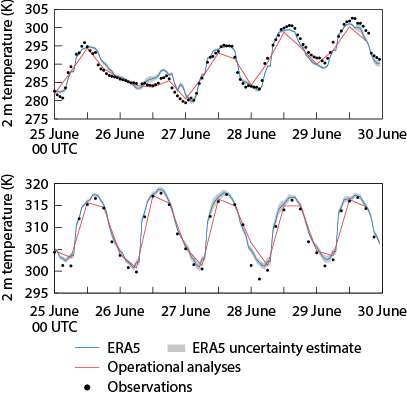After many years of research and a great deal of technical preparation, the production of a new ECMWF climate reanalysis to replace ERA-Interim has started. ERA5 will be the fifth generation of ECMWF atmospheric reanalyses of the global climate, which started with the FGGE reanalyses produced in the 1980s, followed by ERA-15, ERA-40 and most recently ERA-Interim.
Reanalyses provide a numerical description of the recent climate by combining models with observations. They have been invaluable to numerous users in Member States and around the world and have always been closely associated with the excellence of the Centre’s forecast products. Reanalysis is now a key ECMWF contribution to the implementation of the EU-funded Copernicus Climate Change Service. This is reflected by the fact that ERA5 is the first reanalysis produced as an operational service rather than a research project.
Once complete, approximately two years from now, the new ERA5 reanalysis will span the modern observing period from 1979 onward, with daily updates continuing forward in time. ERA5 will eventually replace ERA-Interim, which is increasingly difficult to maintain. ERA5 data will be at a much higher resolution than ERA-Interim: hourly analysis fields will be available at a horizontal resolution of 31 km on 137 levels, from the surface up to 0.01 hPa (around 80 km).

All ERA5 data products will include information about uncertainties, which will be provided for each parameter at 3-hourly intervals and at a horizontal resolution of 62 km. Many new parameters, such as 100-metre wind speed and direction, will be available as part of the output. A database containing all ingested observations, together with detailed information about how they are used, will be available and accessible to users. Altogether, the entire ERA5 production will generate roughly 5 petabytes of data.
The research conducted at ECMWF since the start of ERA-Interim in late 2006 gives us great confidence in the quality of the ERA5 reanalysis. The ERA5 data assimilation system uses the current version of the Integrated Forecasting System (IFS Cycle 41r2), with several added features specifically developed for reanalysis. The many changes and improvements incorporated into the IFS represent a decade of research and development in modelling and data assimilation. The ERA5 reanalysis will also benefit from the research conducted in the EU-funded ERA-CLIM and ERA-CLIM2 projects carried out by ECMWF and partners. These have led to improved input data for the assimilating model that better reflect observed changes in climate forcings, as well as many new or reprocessed observations for data assimilation.
Some of the main characteristics and innovations in ERA5 with respect to ERA-Interim are listed in the table.
|
ERA-Interim |
ERA5 |
|
|---|---|---|
|
Period |
1979 – present |
1979 – present |
|
Production period |
August 2006 – end 2018 |
Jan 2016 – end 2017, |
|
Assimilation system |
IFS Cycle 31r2 |
IFS Cycle 41r2 |
|
Model input |
As in operations |
Appropriate for climate (e.g. CMIP5 greenhouse gases, volcanic eruptions, |
|
Spatial resolution |
79 km globally, 60 levels to 0.1 hPa |
31 km globally, 137 levels to 0.01 hPa |
|
Uncertainty estimates |
None |
From a 10-member Ensemble of Data Assimilations (EDA) at 63 km resolution |
|
Output frequency |
6-hourly analysis, 3-hourly forecast fields |
Hourly analysis and forecast fields, |
|
Input |
As in ERA-40 and from Global Telecommunication System |
In addition, various newly reprocessed datasets and recent instruments that could not be ingested in ERA-Interim |
|
Variational |
Satellite radiances |
Also ozone, aircraft and surface |
|
Satellite data |
RTTOV-7, clear-sky |
RTTOV-11, all-sky for various components |
|
Additional innovations |
Long-term evolution of CO2 in RTTOV, cell-pressure correction SSU, improved bias correction for radiosondes, EDA perturbations for sea-ice cover |

